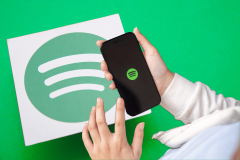
A recent Apple commercial, “Strength,” highlights all the ways you can use an iPhone with fitness apps and gadgets. At Google’s I/O conference last month, the tech company unveiled Google Fit, a set of software which aims to put your Android phone similarly at the center of your digital workout routine.
To my eye, those visions, though presented as innovative, seem less futuristic and more about maintaining the status quo. As the dominant players in smartphones, it’s very much in Apple and Google’s interests to keep the phone in a central role. But as new technologies emerge, that may be changing.
https://www.youtube.com/watch?v=xTjejvnBJfU
The thing the smartphone has going for it is an always-on Internet connection. If a heart-rate monitor or activity tracker wants to talk to a server in the cloud, right now, a phone serves as the gatekeeper—typically using Bluetooth to tie everything together.
That state of affairs is so much better than the so-last-decade alternative of connecting devices to our laptop or desktop computers.
And yet it’s limiting. For one thing, not everyone wants to exercise with a smartphone strapped to their arm. ReadWrite’s Matt Asay runs phone-free. And there are some places where you won’t want to take a phone, like a swimming pool or heated yoga studio.
The answer is not likely to be a general-purpose smartwatch with a few fitness sensors added, like the Samsung Gear Live. Like the other recently released Android smartwatches, it’s crippled without an Android phone nearby. As Dan Rowinski has written, we need to wait for a new generation of components to see standalone smartwatches that aren’t mere smartphone companions.
You don’t need a do-it-all device to track your fitness, though. You just need one that does a few specific functions well.
Living The Phone-Free Life
See also: Apple May Be Giving Fitness-App Makers The Bluetooth Blues
The Bia Sport Watch is one phone-free device that I find particularly interesting. For $279, it tracks running, swimming, and biking, and can display heart rate from a separate chest strap. Most intriguingly, it can send a distress text message with a map of your location. And it uploads workouts directly to MapMyFitness or Strava.
It does all of this with a companion gadget called a Go Stick, which is essentially a specialized cellular modem. It uses 2G wireless—an older, cheaper form of connectivity that works well for small amounts of data. (The Bia doesn’t need a fast 4G connection to just transmit run data or send a text.) Right now, the emergency-text and upload features are included as part of the price, though Bia says it may charge for more connectivity features in the future.
Another interesting example of a smartphone-free device is the Whistle activity tracker for dogs. While you use your phone to configure it, the Whistle thereafter independently connects to Wi-Fi networks to report your dog’s walking and playing time. The forthcoming WhistleGPS, due out next year, will actually track your dog’s location through a new kind of low-cost wireless network known as “sub-Gigahertz” technology.
Of course, we’ll still use smartphones in conjunction with these devices. You’ll review Bia workouts using a MapMyFitness app on your phone. Whistle has a companion smartphone app that lets you see your dog’s activity. For data display and device configuration, smartphones will remain the remote control for our digital lives.
Among general-purpose devices, the Pebble smartwatch is the one to beat. While Apple and Google will want to keep phones at the center of things, Pebble has no smartphone business to protect. Right now, the device may depend on a smartphone, but Pebble CEO Eric Migicovsky told me he hopes the watch itself will become a hub for other wearables. Or just take over their functions: Pebble now offers new fitness-tracking software from the fitness-device maker Misfit that essentially duplicates its standalone Shine wearable on the Pebble.
The end result of this move toward independence is that won’t need to spend as much time syncing, twiddling, and troubleshooting device-to-phone connections. Right now, there’s a lot of finger-pointing between app designers, device makers, and smartphone platforms when things go wrong—as they too often do.
When devices have their own Internet connection, it’s easier for their manufacturers to take full responsibility for how they perform, from gathering data to transmitting it to servers to sharing it with other apps. We’ll require new networks, new components, and new thinking—but independence is coming.

















